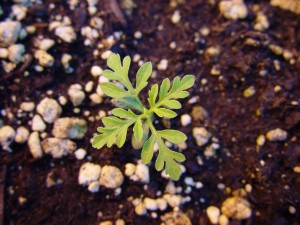
Common ragweed – Ambrosia artemisiifolia
Ambrosia artemisiifolia L.
Asteraceae (Aster family)
MI Status
Native
Life cycle
Erect, branching summer annual.
Leaves
Cotyledons are thick and oval to spatula-shaped. Leaves are fernlike, once or twice compound and usually hairy. Upper leaves are alternate; lower leaves may be opposite or alternate with distinct petioles.
Stems
Usually hairy, erect and branched up to 6 feet tall.
Flowers and fruit
Flowers are generally inconspicuous, found on terminal branches. They produce prolific amounts of pollen. The seed is enclosed in a single-seeded, woody fruit with several spikes resembling a crown.
Reproduction
Seeds.
Similar weeds
Giant ragweed (A. trifida L.)
Differs by having cotyledons three to four times larger; three- to five-lobed leaves opposite in arrangement; and a height that may reach 15 feet.
Western ragweed (A. psilostachya DC.)
Differs by having a perennial nature with prolific creeping roots, densely hairy leaves and a height typically not above 4 feet.



Other Documents in this Series
You Might Also Be Interested In
-
Celebrating 100 years of Michigan State University Extension in Alcona County
Published on October 19, 2017
-
MSU named Top 10 agriculture and forestry college in new report
Published on March 23, 2021
-
Protecting Michigan’s environment and wildlife through the Conservation Reserve Enhancement Program
Published on September 1, 2021
-
MSU to study precision livestock farming adoption trends in U.S. swine industry
Published on March 15, 2021
-
MSU Extension to undertake three-year, $7 million vaccination education effort
Published on August 17, 2021
-
Inspired and in-person: face-to-face programming returns for Michigan 4-H
Published on August 25, 2021
Accessibility Questions:
For questions about accessibility and/or if you need additional accommodations for a specific document, please send an email to ANR Communications & Marketing at anrcommunications@anr.msu.edu.



 Print
Print Email
Email




